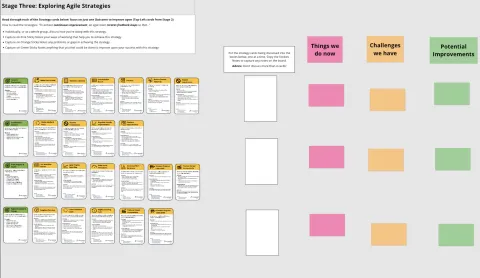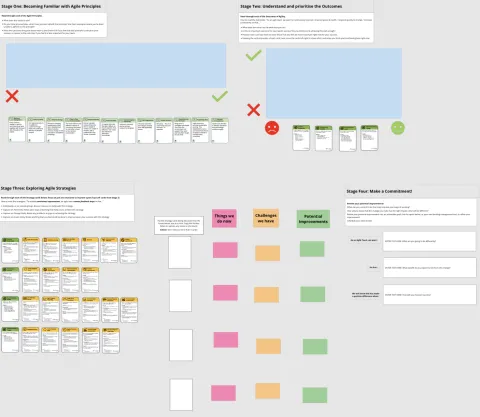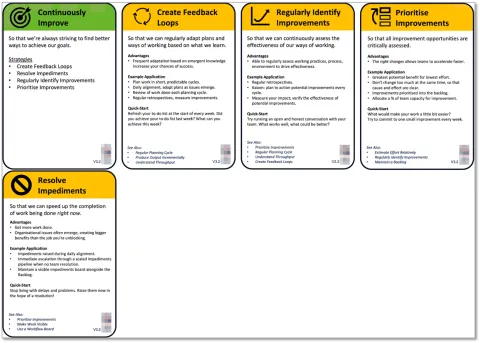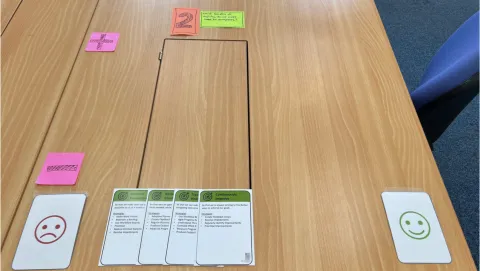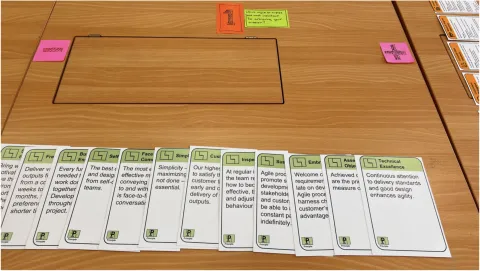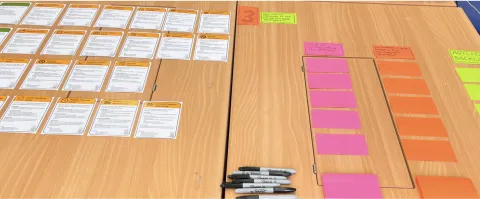Serious gaming to encourage and nurture an agile mindset, beyond just software and product delivery teams, using jargon-light agility cards.
Several months ago, I designed a set of cards to describe agility to teams unfamiliar with the jargon commonly used in product development and software engineering. They are downloadable for free at the bottom of this page, as well as from my original article that describes how I came to create the cards.
Since publishing, they have become a popular download on the Ivar Jacobson web site. Having used them myself, I’d like to share how I’ve been getting on, what I’ve learned and how they can help a team to better adopt an agile mindset.
This article goes on to describe one way that I’ve been using the cards.

Review your Ways of Working
In my experience, nobody starts with zero agility. I’d suggest it’s all about degrees of agility, i.e., do our current working practices allow for changes of direction, as often as required, while minimising the cost of change? I wanted to be able to facilitate a discussion – without using product or software specific terminology - along the lines of:
- What is important for our success?
- How well do our current ways of working facilitate this?
- What should we do differently to improve?
In other words, I wanted to design a team-led review of their ways of working. Team-led, as opposed to practices-led; “how good are you at achieving the practices you’ve chosen to use?” is not the same question as “are you as successful as you need to be with the practices you’ve chosen to use?” For this, I thought that my new Agility cards would be a great starting point.
The structure of the workshop looked something like this:
- Using Agile Principles as a foundational guide.
- Agree the Outcomes you’d like to achieve.
- Explore Strategies commonly adopted to help achieve those outcomes.
- How do your current Ways of Working help you to achieve this?
- Agree on specific improvement opportunities.
It’s designed to be a regular event. Teams I’ve worked with are trying to do this monthly, which should help to keep the conversation alive without overwhelming them. I’d consider doing this often enough that you learn quickly from any adjustments you make, but not so often that you can’t properly assess the impact of changes made, which will depend on the pace of the team.
Stage 1: Start with Principles
Any discussion is only worth the cost if it leads to some decisions. The decisions we were looking to find during this activity were potential improvements, leading to more adaptive ways of working. I wanted to make sure the discussion initially focussed on what agility means to the team and why it’s important for the context in which they work. We needed an anchor, so started with the 12 agile principles.

Since the teams with which I’ve been working are not product development teams, some of the language used to describe the principles also needed adjustment to move away from product and software specific terms. Don’t be afraid to reword if doing so facilitates better discussions!
I wanted the teams to connect with the concept of agility and have found this to be time well spent. Using agile principles as the foundation for the workshop also allows you to continually refer to them, maintaining focus and exploiting any coaching opportunities.
This is relatively easy to facilitate, and has prompted some very rich discussion points, helping to achieve buy-in. I like teams to explore the principles for themselves and have found this to be far more powerful than lecturing the group!
-
Ask the team to take turns selecting and reading out one of the principles.
-
Allow for some clarifying questions and discussion to help people agree what the principle means to them.
-
Ask: how important is adherence to this principle for your success?
-
Order the cards left to right by their importance to the team.
Happily, the most surprising aspect of this for me is that each team, in discussion of the principles, has naturally tended to relate them to examples from their own workspace with minimum effort from myself. This goes a long way to gaining buy-in for adapting how the team works.
People should feel safe to dismiss any of these principles as unimportant. I find it useful to challenge this through coaching, perhaps addressing misinterpretation, while making sure I never imply they are wrong. You’re looking for buy-in and for the team to get to a shared understanding of which principles they hold in the highest regard. This is very useful later, because you can refer to the principles to help validate any adjustments the team is looking to make to their ways of working.
“If you make this change, does it help you adhere to the principles you agreed to be important for your success?”
Stage 2: Prioritise Desired Outcomes
The second part of the workshop helps to narrow down the scope of the discussion by understanding and prioritising the outcomes - the 4 dark-green headed cards in the Agility deck - based on what the team most needs or wants to achieve next. It’s hard to do justice to everything all at once and if you try to cover too much in any single session, you’ll likely run out of time and probably motivation before really achieving your goals.
The way to read these cards is: “As an agile team, we want to continuously improve / track progress & health / respond quickly to change / increase productivity so that…”

Once again, the facilitation is light-weight, and the team should do most of the talking. It’s also worth finding a large space in which to run these sessions. Having each stage of the workshop set up around a big table means you can get the team to physically move around the room as you step through the activities. This seems to increase people’s willingness to participate in the discussion.
-
Again, ask individuals to read out the cards one at a time. Try to avoid getting into the strategies listed on the cards. The team needs to understand the intent of the card, not how it is achieved at this point.
-
Allow for clarifying questions and some discussion to help make the outcome feel more relevant to the team’s own challenges.
-
Ask: is this an important outcome for your team’s success? Do you think you’re achieving this well enough? You can hopefully see from the image above that the cards can be positioned top to bottom to reflect their importance and left to right to reflect how well they’re being achieved.
-
You will have a deeper dive into the strategies in the next section, so try to keep the conversations out of the depths at this point!
Once the cards have been positioned, you have your priority to take to the next stage of the workshop. The card nearest the top-left (important to the team and least well achieved) should be verified as the outcome they wish to improve upon. You don’t have to use this method; it’s just a way to drive an understanding of the outcomes and to provide a focus for the next stage. As you do more of these sessions, the team could just pick a card!
Stage 3: Explore the Strategies for Achieving your Chosen Outcome
So far, we’ve hopefully achieved some buy-in for change, by making the agile principles relevant to the team and their unique context. We’ve also narrowed down the scope of the workshop to the one outcome that the team chooses to focus on.
I initially underestimated the time to get to this point. The first team I helped in this way took over an hour to discuss the principles. A worthwhile discussion that very definitely helped lead to a successful outcome. I had this down as 15 minutes on my plan! Sometimes that’s easily enough time if the team is already familiar with the principles. My only advice here is, adapt your plan and try not to cut off good discussions.
We now come to the strategies that agile teams commonly adopt to achieve the outcomes discussed in the previous section. These are the orange-headed cards in the Agility deck.
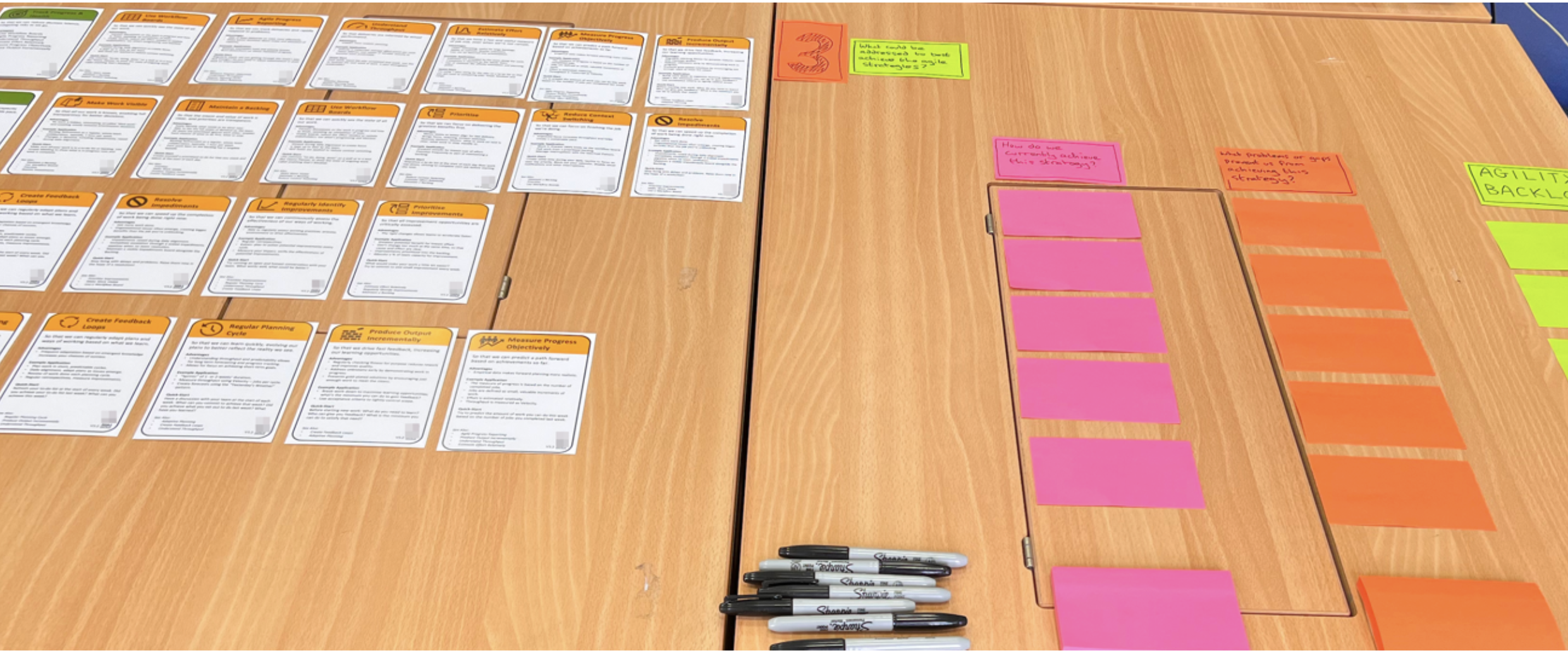
As you can hopefully see from the image above, I arranged the strategies into swim-lanes headed by the outcome they collectively achieve. Once you’ve decided which outcome to focus on, you can remove the others. You’ll also note on the right-hand side of the picture, I created an area for taking notes and recording potential improvements.
Cards can be moved around, people can keep hold of them, they can fall on the floor, etc. so I also created a handout for each outcome and gave one to every person in the room so they can see all the strategies together with the outcome, regardless of what’s happening on the game board!
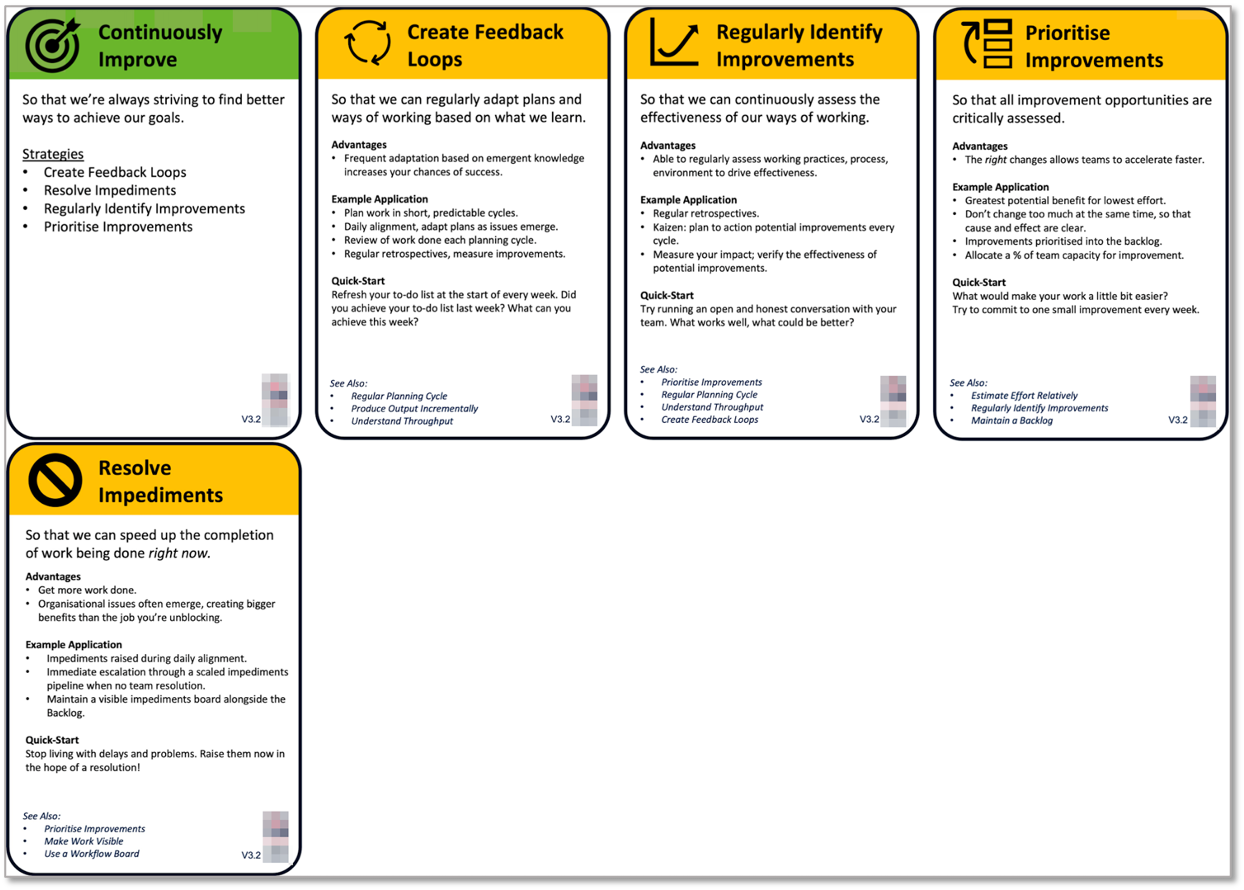
This is probably the hardest part of the workshop; if the team agrees to try just one potential improvement, you’ve met the goal!
Here’s how the session can run, though there are a lot of personal style choices in here and good arguments for varying your approach:
-
Get the team to look at and read out the first strategy card for your chosen outcome.
-
The way to read the strategy cards goes something like, “to achieve continuous improvement, an agile team creates feedback loops so that…” The grammar doesn’t always precisely fit, but it tends to make sense!
-
I’ve tried a couple of different methods for facilitating the discussions at this point. You’re looking to capture notes on what the team does right now to fulfil the strategy and what problems or gaps they need to solve or fill.
Option 1: Individual Feedback: Ask the team to spend 10 minutes individually writing on sticky notes anything they do now that helps to fulfil the strategy and any problems they have or gaps in achieving it.
Group and discuss all the points raised. This is a great time to find coaching opportunities and to point the team toward working practices that they might want to try, or any adaptations to their existing practices that your experience tells you may help them.
Capture any potential improvements on sticky notes as the discussion is ongoing. I’ve found it useful to have a second facilitator in the room to help with this, (my ears tend to switch off when I’m taking notes!)
Option 2: Group Discussion: Facilitate a discussion as a whole group, capturing points and potential improvements on sticky notes as you go.
With less experienced teams, I’ve found option 2 to be the better choice – although that may just be personal style. More experienced teams - for example, those who have used a specific method like Scrum for a while - might be more successful with option 1. You will probably have many other methods to use, so give it a try!
You don’t have to go through all the strategies, but I would recommend taking the time to do this when you’re going through the activity for the first time.
One of the primary take-outs from this whole session is to help teams think differently – often called adopting an agile mindset! How do agile teams think when they’re adopting or adapting their ways of working? What are they trying to achieve and why?
Exploring the strategies, with examples of how teams in your experience have achieved success, helps others to accept the practices you’re recommending – and let’s be honest, sometimes mandating!
Stage 4: Make a Commitment!
You should now have a list of potential improvements. The final step – leave at least 15 minutes for this – is for the team to organise, prioritise, refine, and commit to something that they feel they can achieve and to walk away with a backlog of potential improvements.
I have helped teams to refine the backlog that they’ve committed to, making sure their changes are measurable. Get their backlog visible and try to schedule a follow up session; I would recommend monthly to begin with and adapt from there.
Follow up Sessions
The first sessions I ran with teams took time: 2 to 3+ hours! As you can see, it’s not something to rush, nor is it trivial. You’re trying to do a lot with the team, taking one of its first steps toward adopting a more agile mindset.
I’d recommend retaining the game board, with all cards and notes in place, perhaps just take a picture. You then have a good reminder, and some choices for the follow up sessions.
Kick off with a review of any agreed changes from the last session. Did this help the team? What did we learn? What do we want to do next? (stop/adapt/continue)
Stage 1 could be a quick review and reminder of the principles; deeper dive if you feel the need. Does the team feel any differently about their relative importance? I would try just having them visible on the game board.
Stage 2 you could ask the team to just pick a card! I’d remind people of the intent of each of the cards first, to kick-start the discussion.
Stage 3 can be varied in any way you feel will get you to the outcome. Perhaps also just choose a single strategy to focus on.
While the first session should take a more significant investment of time, subsequent sessions don’t have to.
In Conclusion
I’ve found in using the Agility cards that they have helped me to gain buy-in from teams that may otherwise be alienated by the jargon we use with common agile methods.
Starting the conversation with Principles, Outcomes and Strategies in plain language can very quickly move people to the same understanding of what we’re trying to help them achieve and why. I’ve found it much easier to have this conversation in the context of their own work, rather than trying to reverse engineer the practices with examples that might be hard for them to relate to, especially when teams are far removed from those with which I’ve worked before.
This leads very nicely to recommendations and coaching opportunities. The complex question of how becomes collaborative, helping to ensure we’re not pushing the teams we’re trying to help.
A final point I’d like to reiterate is, these cards are a concept, not something that is fixed. You can create your own, reword them to match the context you work in or change the examples on the cards to resonate better with your personal style. For example, one of the outcomes on the cards reads: Increase Productivity. This works well for the organisation I’m working with, but I can imagine an allergic reaction from some of the teams I’ve previously encountered. This could equally read: Improve Time to Market, or something along those lines. Adopt and adapt, as with anything else!
I hope you find this useful, and please download and use the cards for free! I’d love to hear how you are using these cards and what outcomes they’ve helped you to achieve.
Richard Cook is a Principal Consultant for Ivar Jacobson International.
Download the full deck of cards below
Visit our Coaching Card Download Hub for lots of other great card assets.

